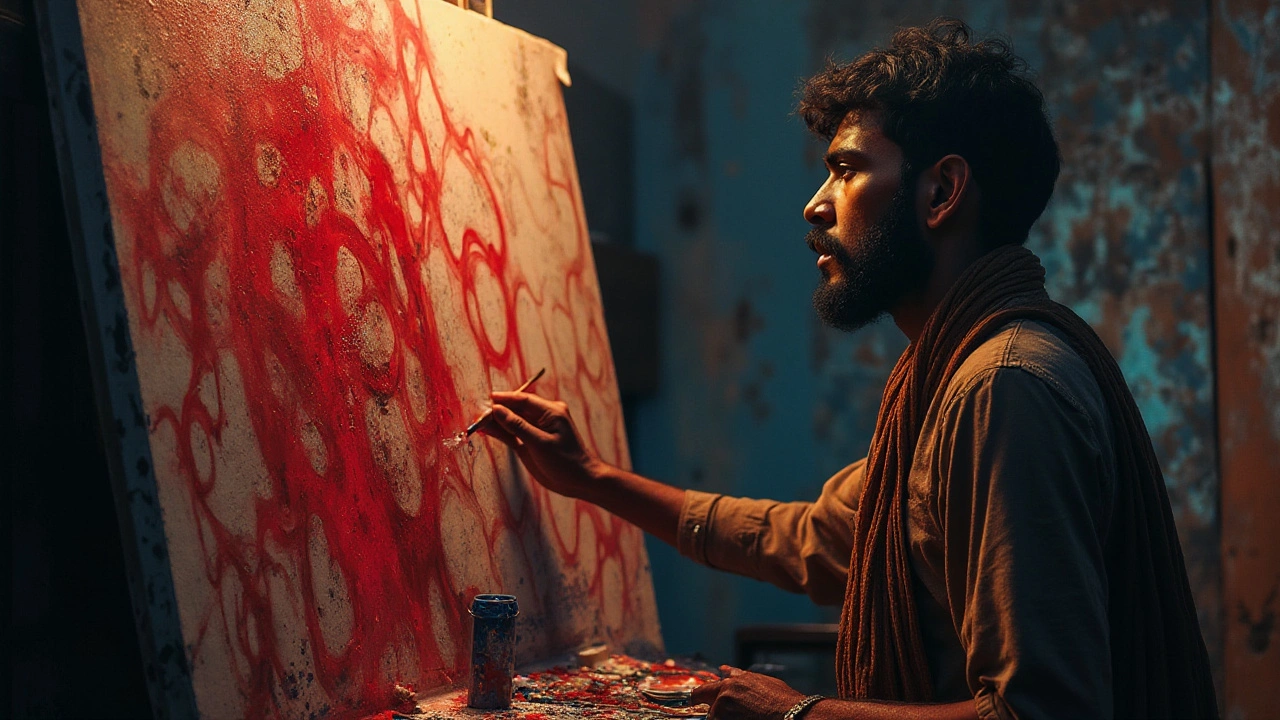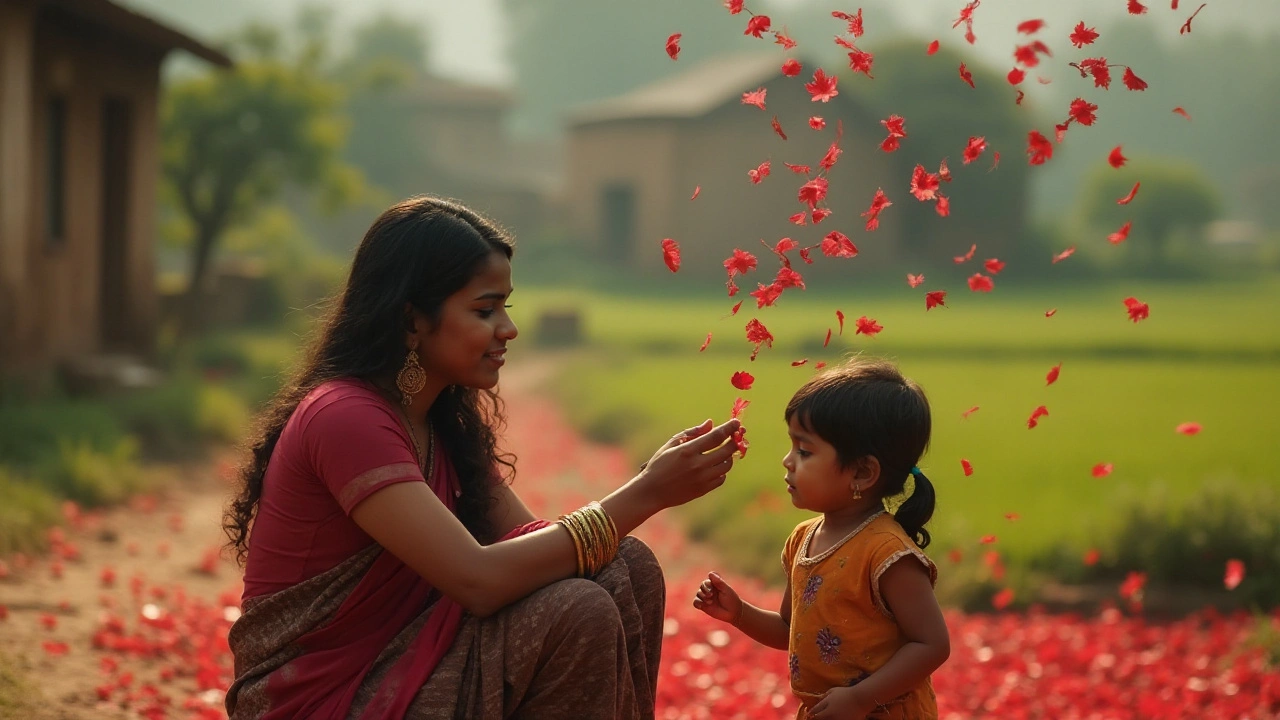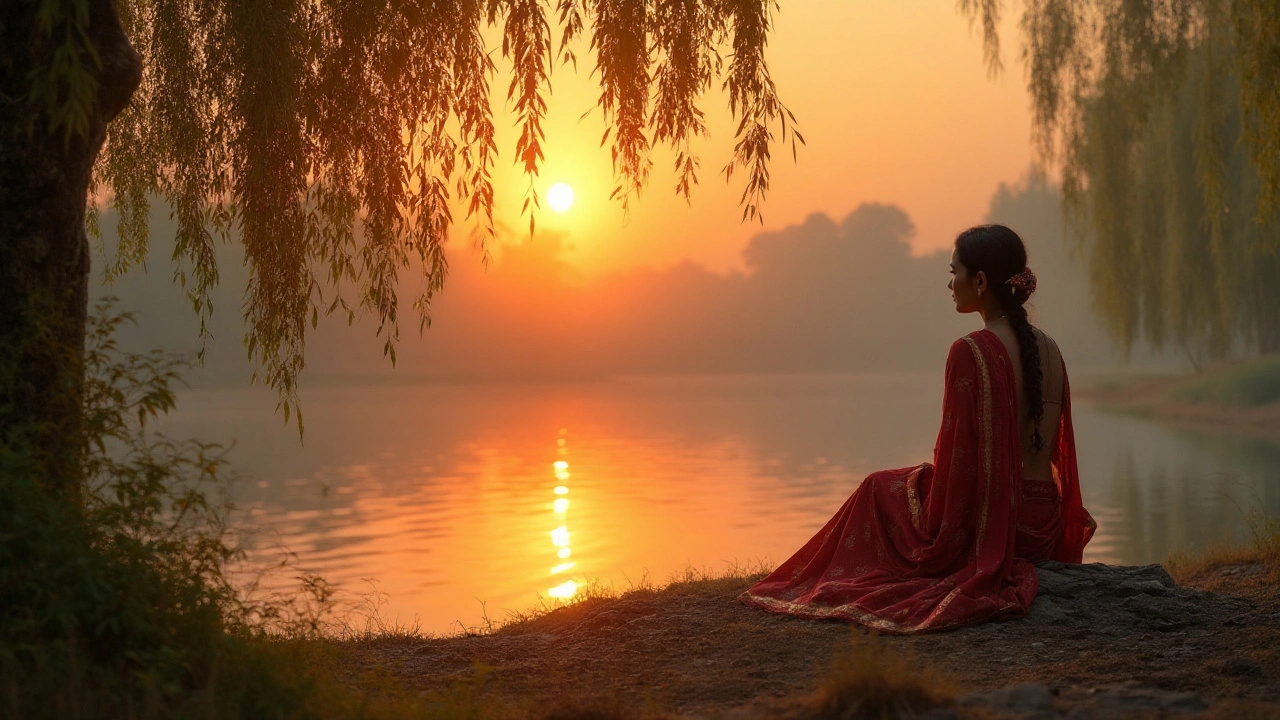They say when sorrow grips the heart fiercely, even the tears shed are no longer pure and clear, but instead, resemble drops of blood. This imagery, both poetic and haunting, speaks to the soul—a poignant representation of pain intensely felt.
In a country as culturally rich as India, tears are more than just an emotional release; they are steeped in tradition, expressing grief and connecting souls through shared experiences. This article journeys through the intricate dance of emotions and explores how poetry captures these profound moments, turning personal torment into a universal story of resilience and hope.
- The Metaphor of Bloody Tears
- Tears in Indian Culture
- Scientific Perspective on Tears
- Expressing Sorrow Through Poetry
- Finding Solace in Words
The Metaphor of Bloody Tears
The metaphor of bloody tears powerfully resonates with those who have experienced profound sorrow and heartbreak. It goes beyond the literal interpretation and plunges into the depths of human emotion. The idea is that when pain becomes unbearable, our tears—symbols of our sorrow—are imagined to transform into something as visceral and shocking as blood. This transformation is not merely about physical pain but an emotional catharsis where sadness and grief become overwhelming. Literature and sad poetry are replete with such imagery, using it to articulate the unspeakable—the kind of pain that feels at once intimate and universal. Tears have always held a significant place in the tapestry of human expression, freeing the soul from the shackles of agony.
In Indian culture, tears are profoundly symbolic and often wrapped within rich traditions and beliefs. They are not just tears of sorrow but also bear witness to the joys, struggles, victories, and defeats that weave the narrative of life. The archetype of bloody tears finds its roots in the ancient texts and myths where deities and heroes shed such tears in moments of grave despair or divine sacrifice. This imagery has transcended through time and has been embraced by poets, authors, and artists who know too well the power of such stark symbolism. By engaging with the metaphor of bloody tears, creators tap into a wellspring of emotional depth, bridging the gap between personal agony and shared human experience.
Science, on the other hand, offers its own perspective on why we shed tears, contributing a layer of understanding to why this metaphor is so arresting. Emotional tears, unlike their basal or reflex counterparts, contain proteins and hormones associated with stress. While they do not literally turn to blood, they reflect the body's response to extreme emotional states. Some scholars have suggested that emotional tear-shedding could be a social signal—a way to evoke empathy or help from others. This notion intertwines with the metaphorical interpretation of bloody tears by highlighting the bridge between the emotional and the biological, broadening the scope of understanding beyond the poetic to the scientific realms.
The imagery of tears transforming into blood captures the heart's struggle, speaking to a truth beyond words. As the poet John Keats once observed, "A thing of beauty is a joy for ever," suggesting that pain, too, when transmuted into art, becomes an eternal testament to the human spirit's resilience.It is through such exploration that the metaphor becomes alive, enticing the reader to delve deeper into how their own lives relate to these expressions. The currency of bloody tears in storytelling and art serves as a powerful reminder of our shared humanity, making the invisible visible, and allowing expression of the deepest wounds.
Tears in Indian Culture
In the vast tapestry of Indian culture, tears hold a significant place, reflecting the deep-seated emotions tied to various life experiences. These tiny droplets are often seen as a bridge between the human and the divine, a testament to the authentic human experience. In India, crying is not just about expressing sadness; it is an integral part of expressing joy, relief, and even worship. Weddings, funerals, and spiritual ceremonies often witness tears as a profound expression of emotions. During marriage ceremonies, tears shed by the bride leaving her parental home signify the bittersweet transition to a new life—a moment known as ‘bidaai’ in traditional Hindu weddings. This ritualistic weeping embodies the complex emotions of leaving behind one's past for uncertain futures.
The symbolic power of tears is enshrined in Indian mythology and literature. The epic tales of Mahabharata and Ramayana often depict heroes and gods shedding tears, humanizing these revered figures. Take, for example, Lord Rama’s grief at being separated from his wife Sita, which showcases his deep emotional vulnerability. These stories remind us that tears are universal, transcending the divine and mortal realms. A famous quote from the sage Patanjali beautifully encapsulates this sentiment:
"Tears are the sacred waters that cleanse the soul, illuminating the spirit with a light of new understanding."
The notion of equating tears to spiritual cleansing has been ingrained within the Indian psyche for centuries, fostering a cultural acceptance that's deeply empathetic. This emotional openness is often reflected in Indian poetry, where tears are a poetic device employed to convey heart-wrenching sentiments and unspoken sorrow. Many revered poets like Mirza Ghalib and Rabindranath Tagore have woven their verses with imagery of tears, elevating them to art forms that resonate with readers on a profound level.
In contemporary times, the expression of tears in India's burgeoning creative scene continues to thrive, often seen in the rich narratives of Bollywood, our vibrant film industry. Movies like "Kabhi Khushi Kabhie Gham" and "Devdas" showcase characters expressing deep anguish and uncontainable joy through tears, mirroring the audience's own experiences. This cinematic portrayal reinforces the cultural narrative that embracing vulnerability through tears is not just acceptable but enriching.
Tears are shrouded in multiple layers of meaning within the Indian cultural ethos. They serve as a cathartic release, a symbol of humility and surrender, as well as a universal language spoken between people, transcending barriers of language and religion. This emotional fluidity has allowed Indian poetry and cultural expression to remain relevant across generations, illustrating the timeless nature of tears in shaping the narrative of human connection and empathy.

Scientific Perspective on Tears
Tears are more than mere drops of salty fluid; they are a complex concoction orchestrated by the most exquisite mechanism within the human body. Scientifically, tears are classified into three distinct types: basal, reflex, and emotional. Each type plays a pivotal role in the ocular health and emotional expression of humans. Basal tears are ever-present, much like a silent guardian, constantly keeping our eyes lubricated and protected from external irritants. Reflex tears, on the other hand, are the body's instant reaction to foreign particles—triggered when chopping onions or when a speck of dust disturbs the eye's tranquility. Indeed, tears are brilliantly functional as well as deeply emotional, embodying both a physical necessity and an emotional outlet.
Emotional tears, the ones most associated with our response to intense feelings, contain a higher concentration of stress hormones such as adrenocorticotropic hormone and leucine enkephalin, a natural painkiller. This unique composition has led researchers to propose that crying might indeed serve a therapeutic function, helping us process stress and emotional burdens. The act of crying can stimulate the production of endorphins, chemicals in the brain that act as natural tranquilizers and pain relievers. Therefore, the seemingly simple act of shedding tears can be remarkably effective in alleviating emotional turmoil, allowing us to emerge from distress more balanced and resilient.
"Tears are words the heart can't express," noted writer Gerard Way. This insight underscores the intricate connection between our emotional landscape and our physiological responses, indicating not just a release, but a profound form of non-verbal communication.
In an interesting study by biochemist Dr. William Frey, it was found that women cry significantly more than men, about 64 times a year compared to men's 17. This insight offers a glimpse into how societal norms and biological factors converge in emotional expression. Though we cannot dismiss cultural and individual variables, there is a universal understanding across cultures in the cleansing act of crying, revealing a vulnerability that is paradoxically linked to strength. The profound impact of tears on human psyche and body points to the intricate interplay between emotional well-being and physical health.
The journey into the world of tears doesn't end here. Scientists today are exploring new horizons, delving into understandings of how cultural backgrounds can shape tearful expressions. As we unearth more about this remarkable human phenomenon, we learn not only about the chemistry of tears but also their profound power in the realm of sad poetry, where they elegantly transform intangible sorrow into healing prose, particularly in a culture steeped in emotions like India.
Expressing Sorrow Through Poetry
Poetry has long been a vessel for channeling deep emotional experiences, providing a way to articulate feelings that often seem too complex to convey in daily dialogue. In the enchanting land of India, the tradition of using verse to express sorrow has roots that dig deeply into the cultural soil. Each word and line is imbued with the pain, frustration, and eventual catharsis of the poet's journey. This rich tapestry of expression allows individuals not only to confront their emotions but to share them, offering a sense of solidarity in sorrow.
Throughout Indian history, poets such as Mirza Ghalib and Rabindranath Tagore have painted vivid pictures of human suffering, using their art to transform pain into beauty. The haunting lines of Ghalib often depict the torment of love lost, while Tagore's work examines the existential desolation that comes from realizing the fleeting nature of human connections. These literary giants have endowed their sorrowful subjects with an elegance that transcends time and language. As Tagore once noted, “The butterfly counts not months but moments, and has time enough,” encapsulating the wisdom in acknowledging each bright and dark moment equally.
Creating poetry becomes an act of healing, a way to make sense of the chaos within. The very act of penning down words compels the author to not only confront their sorrow but to transcend it, creating an evolving narrative from personal turmoil. These poetic expressions become outlets for emotions too potent to bear in silence. Beyond their literary value, they serve as historical documents of perennial human angst, offering insight into the struggles faced across eras. Many psychologists suggest that writing poetry can be a therapeutic exercise for those grappling with depression or anxiety, helping to externalize pain in a structured, meaningful way.
The popularity of sad poetry in India continues to swim deep in today’s digital age, where platforms like social media have revolutionized how contemporary poets share their narratives. Global audiences can now witness and connect with the echoes of emotional battles described in 280 characters or more. A 2023 survey indicated that poetry-related posts, particularly those expressing sorrow, accounted for nearly 15% of literary social content shared in India, reflecting the abiding need to process emotions through creativity.
As one explores this poetic realm, certain themes recur — the inevitability of change, the passage of time, and the endurance of hope despite despair. It is in these verses that vulnerability is celebrated as a form of strength, with each carefully chosen phrase inviting readers into the most intimate corners of the poet’s heart. The interplay between personal suffering and universal themes provides a canvas on which readers project their own sorrows, finding solace in shared experiences. Indeed, the world of poetry becomes a communal space where 'the tears that fall like blood' turn into powerful symbols of resilience and unity.

Finding Solace in Words
In a world where emotions can sometimes feel overwhelming, seeking solace in words offers a comforting refuge. The sad poetry of India, with its rich heritage, provides a profound source of healing for those navigating through the storms of sorrow. Words, when woven with care and intentionality, have the power to transport us to a realm where pain finds a voice, and loneliness meets understanding. Whether through the lamenting verses of Mirza Ghalib or the heart-wrenching stanzas of Rabindranath Tagore, poetry crafts a sanctuary where private sorrow transforms into shared human experience. The rhythm and cadence of words can replicate the heartbeat of aching hearts, offering a mirror to our deepest griefs while simultaneously lighting the ember of hope.
Many poets, throughout history, have emphasized the cathartic nature of writing during times of emotional turmoil. By transforming despair into poetry, individuals not only express their personal narrative but also contribute to a shared heritage of resilience. Stories across cultures show that those who engage with poetry often experience a sense of clarity and relief. They discover glimpses of peace amid chaos. A line or stanza might echo feelings too deep for casual conversation, allowing one to articulate complex emotions with precision and grace.
"Poetry is when an emotion has found its thought and the thought has found words." – Robert FrostConsider the act of selecting each word as an exercise in mindfulness. The focus required to capture emotion in verse can often refocus energy from the chaos of life to the simplicity of creation. Writing and reading poetry can be likened to a personal dialogue where one finds a voice that is, paradoxically, both introspective and universal. In this landscape of language, readers and writers trace connections across the tapestry of human experiences, recognizing that tears, whether metaphorically bloodmarked or not, are a deeply shared element of our existence.
Recognizing the influence of poetry as a bridge to understanding, educators and therapists incorporate it into practices aimed at emotional well-being and education. Poetry workshops and therapy sessions harness the emotive power of words to guide individuals through introspection and healing. From rural villages to bustling cities, endeavors to embed poetry in community experiences reflect its enduring significance. The written word becomes not just art but utility, transforming spaces of darkness into realms lit by shared understanding and empathy.
